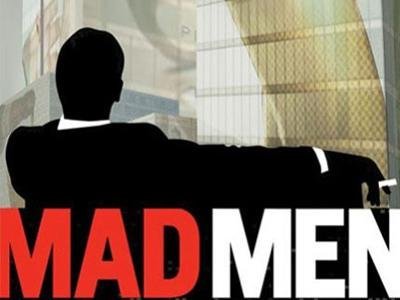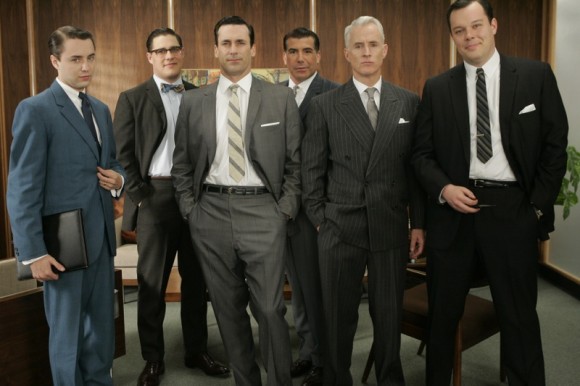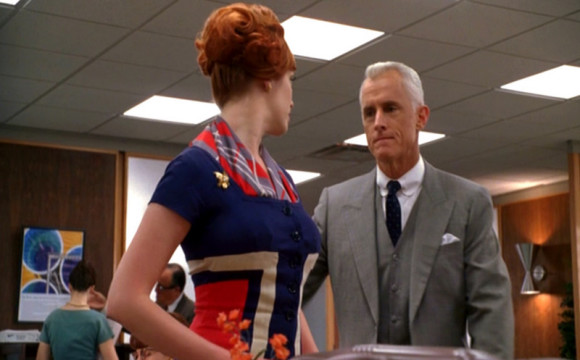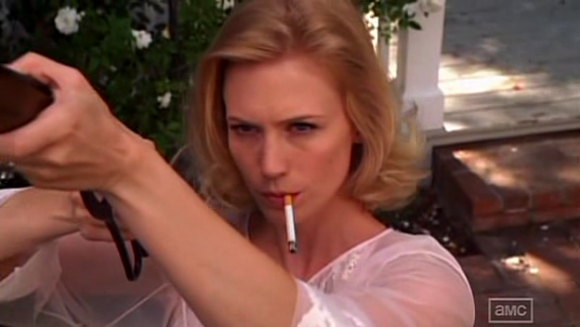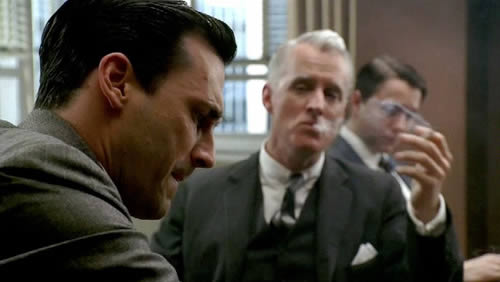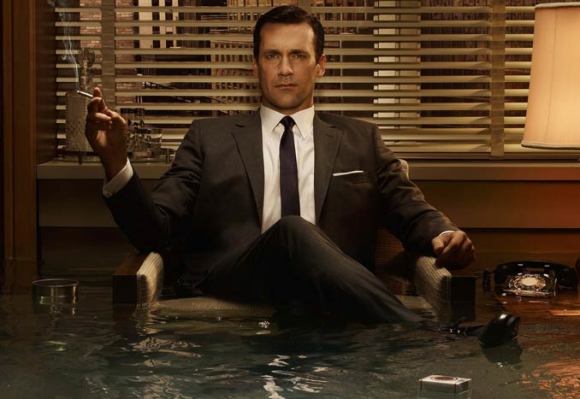Where the Truth Lies: Mad Men’s Deconstruction of American Nostalgia
“Where the Truth Lies.” The tagline of the show Mad Men provides a double entendre to describe its project of digging deeper into the world of advertising. Not only does the show reveal the lies behind the truth posited in advertisements, it also pulls back a curtain to reveal the truth of a decade. The show is set on Madison Avenue in New York, the hub of advertising, following the lives of ad executives in 1960, particularly Don Draper, an especially gifted ad man. Tim Griffin writes,
it seems a fitting irony that, if Mad Men functions as allegory, the drama takes as its setting an ad agency, that place where the world is refigured into representation, organized into a narrative revolving around prompts for desire and identification, illumination and reflexivity—but only at the direction of self-interested parties.[1]
In so many ways, advertising is the perfect subject to study any period, as Roland Marchand also writes,
“Were all other sources of information on the life of today to fail, the advertising would reproduce for future times, as it does for our own, the action, color, variety, dignity, and aspirations of the American Scene.”[2]As such, the creators were able to look at one of main forces of change in our culture, looking both at the changes it caused and reflected. Season One of Mad Men breaks through the advertised nostalgia of the 1960s, displaying both an unflattering look at our past, as well as the effects of advertising on our lives.
Advertising, as Warren Susman writes,
“was persuasion and persuasion could and would change the world; but advertising at the moment was doing its greatest and most necessary service in is special relationship to business—by publicizing products and urging consumers to buy them.”[3]
Advertising tells people what to buy and how to live, causing changes in style and marketing; enough that Menken, a storeowner in the show, is passed up by the change, and, as he states in the episode “Long Weekend,” would
“own a store that [he] wouldn’t want to shop in.”
If even the merchants cannot keep up with what they are selling, it is indicative of the power of advertising to continue to sell new products. They were able to shape the culture and style by convincing the store owners and manufacturers as Marchand points out,
“Earnest Elmo Calkins . . . hailed the advertising agency as the potential savior of beauty in the age of mass production. In a machine age, he pointed out, the workman had become a machine-tender who could no longer create beauty in the product through his craftsmanship.”[4]
The power for change lay with the man who owned the machines, and therefore ad agencies played the role of convincing him to implement art into the product.
However, as Jean Kilbourne is quick to point out, these ads are not just merely images and words, but they are “our environment.”[5] The pervasive nature of advertisements is what institutes change;
“There is no harm and indeed much delight in them individually, but their cumulative impact is another story.”[6]
The problem with this is what advertisements create. As the man in “The Hobo Code” says to Don, “You make the lie. You invent want.” These ads have effects on people, telling them what they want, and in many ways, lying to do so.
What Mad Men is trying to do, is display these lies for everyone to see. Many aspects of American “suburbia” are idyllic in our cultural memory. However, Mad Men seeks to uncover what people are either too naïve to see, or do not want to remember. Kenneth Nguyen writes,
The past was a simpler, better time - well, it's a seductive thought, constantly sold to us with a hits-and-memories soundtrack. On first glance, Mad Men might be mistaken for a further reverie upon that theme. The series, set in a 1960s Madison Avenue advertising agency, is visually intoxicating, manifesting that world of crisp offices and darkened martini bars that has long inspired fashion designers from Ralph Lauren to Thom Browne to Jack Spade . . . But if the mise en scene evokes a golden age (and it does), the narrative does something else which is just as enjoyable - and rather more complex. It dares to suggest that that apparent golden age was not so golden after all.[7]
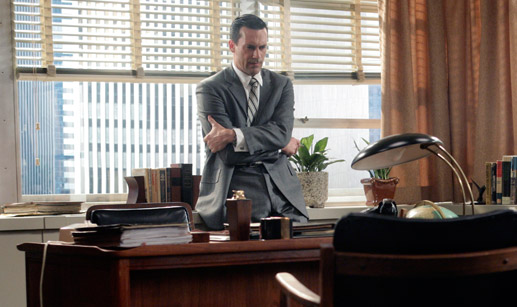
The show displays some of the truth people often ignore in the past and just how much advertising has changed the perceptions of the public of an entire era. In many ways, people have become dependent upon advertising, much as they believe what advertisers are saying about the 1960s;
“Advertising “tells us who we are and who we should be. We are increasingly using brand names to create our identities. James Twitchell argues that the label of our shirt, the make of our car, and our favorite laundry detergent are filling the vacuum once occupied by religion, education, and our family name.”[8]
Not only have advertising and products become necessary parts of our lives, this system is now necessary for advertisers, and they have little reason to change their methods. Marchand states,
“Manufacturers and ad agency leaders recognized their stake in the contemporary configuration of economic and social institutions, and thus found little reason to portray realities that might bring the system into question . . . They dramatized the American dream.”[9]
The pictures created might have been false, but they did not threaten their ability to make money. Therefore, an iconic view of the suburbs was created through advertising. It is a view with faults, and therefore Mad Men seeks to correct it.
When one thinks of the suburbs, they often think of family and community. The 1960s are especially viewed as the ideal time to raise a good family. One of the largest shifts that has occurred since the 1960s, however, is in the sphere of gender roles, both at home and work, which Mad Men does not neglect to focus in on.
Work is the man’s world, and the home is for women. When each gender ventures into the opposite sphere, much struggle ensues, both in finding their place, as well as against stereotypes placed upon them. However, women must find a spot in the workplace, a man must come home every night. In many ways, the culture in the show is still following a older model of defining the roles of gender:
The decisive separation of workplace and home during the previous century had inspired extremely polarized conceptions of the proclivities and capacities of men and women. Man’s proper sphere had been increasingly defined by a life away from home in a world of ambition, severe competition, and the efficient, unsentimental manipulation of people and objects. In compensation, the home, now defined as the woman’s sphere, had assumed the character of a sanctuary. Here the woman preserved the “softer” and more “cultured” qualities of sentiment, beauty, and repose, while progress proceeded apace in the “real world” outside.[10]
One way to better understand both roles is to focus on the view of the housewife, because it is the housewife that most advertising is geared towards. As Marchand writes, “everyone acknowledged that she made at least 80 percent of all consumer purchases . . . advertisers kept her in the limelight.”[11] Advertising presented the ideal housewife, even glamorizing her role in the home, which is what we are left with in our memory; “She was healthy, beautiful, educated, concerned only about her husband, her children, her home. She had found true feminine fulfillment.”[12] But Mad Men shows what it was really like to be a housewife in 1960.
Everything is supposed to be perfect in the woman’s world, or at least it is the role of the housewife to make happen. It made sense for advertisers to portray an ideal of beauty and perfection because “Beauty paid . . . Style induced increased consumption.”[13] Advertising this view of the home caused an increase in sales. They advertised a more modern woman, who was beginning to push the limits of the previous gender roles:
“The woman of yesterday probably could not have done it all . . . for the woman of today is both easy and pleasant. Her new, wide knowledge of values, her new ability to decide for herself, is one of the wonders of the world we live in.” By selecting products off the shelf with “no clerk to persuade her” . . . she has astonished her husband . . . and the world.”[14]
This pressure for perfection even leads to Betty’s inability to accept that there is anything wrong with Don at the beginning of the season. However, there are limits to this lifestyle. William O’Barr argues that Betty
is bored by the limitations of her daily routine. Her African-American housekeeper does most of the domestic work and minds the children so that Betty has little to do except lunch with her friends, ride horses, and drink. She is precisely the kind of woman that Betty Friedan would describe in The Feminine Mystique (1963) and whom feminism would recruit.[15]
She is completely obsessed with her image, which is a by-product of advertising telling her she must be beautiful, and that she is worthless without being perfect. She is obsessed with the family pictures in “5G,” and is frustrated when they do not go according to plan. The responsibility for them lies in her sphere, and Don seems to have no respect for them or her.
Don does not completely undermine her, however, and often strives to give Betty what she wants. The problem is that he always seems to think that what she wants is the “American Dream,” and she is not fully convinced that is what she wants. Don views the situation as any advertiser would: “To be one of the ‘elect’ in today’s society is to have enough money to buy luxury goods.”[16] This leads to a value in objects that Friedan comments on:
If the pattern of ‘happiness through things’ could be established when these women were young enough, they could be safely encouraged to go out and get a part-time job to help their husbands pay for all the things they buy. The main point now was to convince the teenagers that ‘happiness through things’ is no longer the prerogative of the rich or talented; it can be enjoyed by all.[17]
Though this lifestyle seems like it would lend itself to plenty of freedom, it actually causes a lot of stress for Betty. Continually trying to make things perfect, among other things, leads to her bottling up and suppressing many feelings, which starts manifesting itself physically, and her hands start shaking and causing problems in the episode, “Ladies Room.” Don allows her to start seeing a psychiatrist, after much discussion, to help with these issues, but even this lacks any freedom. Any authority she has is still under the watchful supervision of Don; even the confidential nature of therapy isn’t safe from Don checking in. The housewife appears to have been given much authority, but all of it is still under the eye of the husband and society.
This constant pressure and monitoring causes Betty to remain very childish, to where she even slaps another woman in the grocery store in “Red in the Face.” She also is usually in her pajamas around the house. This is either because of her childish nature, that she is practically forced to live a leisurely lifestyle, or that she is fulfilling the housewife ideal of having nothing to do. She wants attention because she is so lonely, and will accept it, whether it is from a nine-year-old boy or Don’s boss. She even seeks out the boy, Glen, because she feels she cannot go to anyone else. She is a child in an adult world and needs someone to connect to. It all culminates in the final scene of the episode “Shoot,” where she starts shooting her neighbor’s doves, letting out her angst at her trapped life.
Another aspect of the 1960s that is recurrently explored in Mad Men is the prevalence of sexuality and infidelity, particularly in the advertising world. Kilbourne writes, “advertising, an enormously important part of our culture, contributes mightily to the climate of denial in which relationships flounder and addictions flourish.”[18] She picks up the theme again later, saying that it
“constantly exhorts us to be in a never-ending state of excitement, never to tolerate boredom or disappointment, to focus on ourselves, never to delay gratification, to believe that passionate sex is more important than anything else in life, and always to trade in old things for new. These messages are a kind of blueprint for how to destroy an intimate relationship.”[19]
Advertising promotes a lifestyle of pleasure and consumption, not of commitment. In the episode “Indian Summer,” women are even able to pursue sexual pleasure independent of men through the weight loss machine and other appliances. It was very strange, and yet women seemed to have a sort of freedom to pursue pleasure that they did not have before, because objects were allowed to replace people.
While Don is in the city, he is always pursuing strong, independent women. In some ways, it is almost a picture of defeat, or at least shock, when we see him at the end of the pilot with his “domesticated” life. His mistresses are an artist and a storeowner, which is fitting because the merge of art and commerce is what embodies advertising. However, it means his escape from work is not really an escape at all. It is almost as if he wishes he could be married to his work rather than the life back in the suburbs. In “Long Weekend” though, it seems he is starting to give these other women up and focus on his wife, especially after Sterling has a heart attack from “living it up” with women in his office. However, his relationship with his wife is ultimately unfulfilling; because she is unhealthy, she is not what he needs, so he turns back to other women. Don is still unable to fully connect with these women however, only in the moment. Advertising
“encourages us not only to objectify each other but also to feel that our most significant relationships are with the products that we buy.”[20]
This infidelity, however, is not without consequence. Marriages are breaking apart because of it in the final episode, and even Betty is getting suspicious.
Although everyone is getting together and having affairs, it seems that no one is really connecting; everyone is still alone and separated. They think they are getting what they want, but they are not at all. One of the most poignant scenes of this is at the end of “Babylon,” where we see Joan and Sterling after a steamy hotel room scene. Yet, after many “meaningful” words, they are left alone on the sidewalk, mere feet apart, and yet the insurmountable distance of their own loneliness separates them. The pursuit of pleasure makes the sexual act tend
“to become mechanized and depersonalized, a physical release that leaves the partners even lonelier than before. The expression of tender sentiments shrivels. Sex becomes the arena for the struggle for dominance and control.”[21]
A large part of this loneliness is due to the fact that “Advertising interprets self-worth to mean valuing one’s self more than anyone else and being absorbed with oneself to the almost compete exclusion of others.”[22] When people become too focused on themselves and their own desires, it becomes impossible to truly love someone and connect with them.
Perhaps the largest curtain Mad Men pulls away from the 1960s is looking at what exactly it is that advertising is trying to sell us, and what it has left us with. Daniel Mendelsohn points this out as a reason for the show’s popularity:
Most of the people who watch Mad Men are, after all, grown-ups - adults between the ages of 19 and 49, which is to say, either younger adults, to whom its world represents perhaps an alluring historical fantasy of a time before the present era's seemingly endless prohibitions against pleasures once taken for granted (careless eating, drinking, smoking, sex); or young baby boomers, people in their forties and early fifties, who remember, barely, the show's 1960s setting, attitudes and look. [23]
Yet, while the show does provoke many similarities, as Marchand writes, advertising’s power lies in its ability to distort;
“As advertisers quickly perceived, people did not usually want ads to reflect themselves, their immediate social relationships, or their broader society exactly. They wanted not a true mirror but a Zerrspiegel, a distorting mirror that would enhance certain images.”[24]
Kilbourne also comments on distortion of advertising, and shows what it promotes, for “Today we export a popular culture that promotes escapism, consumerism, violence and greed . . . it has become crucial to create artificial needs in order to sell unnecessary products.”[25] Again, the advertisers are telling people what they want, and in the end promising a false happiness.
One of the main advertised desires for middle class America is the pursuit of leisure. It embodies so much of the American dream, and in many ways provides an escape from the toils of work and home. Yet, as Mad Men points out, leisure perhaps is not as great as it appears to be. The irony is that “Americans so valued labor-saving devices that they were ‘willing to work harder for them.’”[26] Susman adds on to this by stating, “Leisure was rapidly becoming almost as important as labor, and he must learn a pleasure ethic, if not to replace, at least to put beside, his work ethic.”[27] There seems to be a misunderstanding of leisure that occurs, and what should be freeing is now trapping the desires of the suburban middle class.
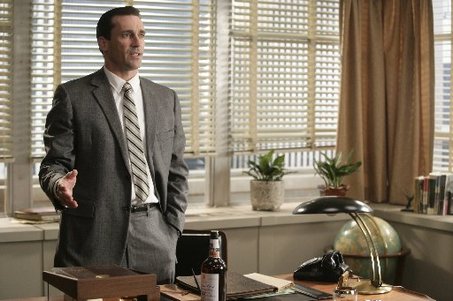
Don is a man who leads a double life, and therefore is constantly looking for an escape from the pressure that entails, on top of the already stressful nature of going between the two spheres of work and home. The train in “Marriage of Figaro” seems to represent Don’s escape from home, his travel to work. Home does not seem to be a place that Don enjoys; even when his beautiful and doting wife is in the bedroom with him, he continues to work. However, work cannot be his only escape. It is so all consuming, and used as an escape for everything else, that his work environment is filled with many escapes as well. The creators of “leisure” constantly partake in its avenues of pleasure. Alcohol and women abound for all of the men.
And yet, as discussed earlier, even these men cannot seem to escape to anything meaningful. The men who inform the world of how to connect and enjoy themselves are still left empty and alone at the end of the day. Don even joins some of his mistress’ friends in smoking marijuana, partly due to pressure from those involved, but it also provides him an interesting escape from the present. When Don’s identity is threatened, he attempts to escape fully from everything. What is interesting about this incident however is that he does not turn to his wife to run away with him. Instead, he turns to Ms. Menken, his mistress; it is an escape within an escape. Don no longer knows what to escape from or to, and is trapped by them all.
As Don himself says in the pilot episode of the show, advertising is all about happiness. However, we get the feeling while watching the show that Don is convincing himself as much as the clients when he says this. He wants to believe that he can be happy, but is surrounded by the depressing nature of life. As he says in “Smoke Gets in Your Eyes,” his philosophy is to “live like there is no tomorrow, because there isn’t one.” When asked how he can perpetuate the lie, he responds by saying “on a bed full of money” in “Babylon.” He has everything he needs to pursue the American Dream, to be happy, and yet he is always unfulfilled. He even views love as made by ad executives to sell nylons. Because he is an ad man, he in some ways sees through the lie, but longs for it to be true. As Jennie Yabroff writes,
the period might just as well be called the age of polished brass, since the idea of truth in ads was just then giving way to primacy of emotional persuasion. Instead of touting a product's merits, advertisers in the '60s strove to evoke a feeling or philosophy--there's a good reason those Marlboro Man ads are considered to be the most successful campaign ever (and notice how everyone on "Mad Men" smokes, even though they're privy to some of the early studies on smoking and health). The stealth approach rules today, when ads sometimes do not even show the product, let alone spend paragraphs explaining why we should buy it.[28]
Because of all of this, he cannot make Betty happy either. The life he is “selling” her is ultimately unfulfilling, and he knows it. Kilbourne states it this way,
“The problem with advertising isn’t that it creates artificial longings and needs, but that it exploits our very real and human desires. In some ways, advertisers know us better than we know ourselves, and they use this knowledge to take advantage of us.”[29]
Most of the draw of the show is not merely in looking beyond the advertisements, but looking into the advertisers themselves, because it is only by looking at the lives of the men who “make the lie” that we can fully understand what the lie is. Because it appears that it is in these men, who work with the lies and dreams of their times, that the consequences manifest themselves most. What is most astonishing is seeing what these men sell to themselves. Repeatedly, when Don is making a speech to his clients, there is a sense that he is trying to convince himself that what he is saying is true, that it’s not just a marketing ploy. In some ways it is this that makes him such a good ad man. Whether he believes it, or if it is true or not, he’s not just coming up with ads to sell products. He is constructing a worldview that he hopes is true, and that carries over to the public. An actual ad executive from this time period, David Ogilvy, states,
“In the modern world of business, it is useless to be a creative, original thinker unless you can also sell what you create. Management cannot be expected to recognize a good idea unless it is presented to them by a good salesman.”[30]
Don lives a double life; his time in the suburbs and the city are completely separate. This seems encouraged, especially with the allure of having a separate life endorsed by the Executive Men’s Bank Accounts in “5G.” Even the secretaries are supposed to facilitate this lifestyle; helping to keep these men’s lives quiet. In many ways, they know more than the wives do because these men seem to have no feeling of obligation to include their wives in their life outside the home. Don has also created a false persona for himself. He is a country boy named Dick Whitman whose mother was a prostitute, but in the army he took on the name of Donald Draper. His entire life since then has been fabricated, and he has lied to everyone, including his wife. Mendelsohn writes,
“He is a man, we learn, who not only sells lies, but is one . . . The rusty and unsubtle device of the double life is meant to establish the pervasive theme of falseness and hypocrisy, qualities the writers find not only in the advertising business, but in the culture of the Sixties as a whole.”[31]
Yet, although Don does so well at his job and keeping up appearances, there is a hint that he is getting tired of this lifestyle, and even advertising. He says he wants to live life, and not just talk about living it in “Shoot.” In “The Wheel,” we see Don at perhaps his most vulnerable state as he demonstrates the Kodak Carousel. Speaking of a longing to go home to places we are loved,
To make his point, he has stocked the projector he uses in the pitch with photos of his own family - which, as we know, is actually in the process of falling apart, because of his serial adulteries. But even so, we can't help submitting to the allure of the projected image of the strong, handsome man and his smiling and beautiful wife: the ideal, perhaps, that we all secretly carry of our own parents, whatever their lives and marriages may have been.[32]
He says the most important idea in advertising is new, but deeper and more delicate is nostalgia. However, he also speaks of nostalgia as a pain from an old wound, that it produces the deepest bond with the product. A twinge in your heart, far more powerful than memory alone.
This view of nostalgia, not as being good, but being pain and a wound, begins to beg the question, is there anything good to remember? If nostalgia is pain, do we just lie to ourselves to get through it all? Do we add meaning so that the past seems better? Tim Griffin states,
We are living, in fact, in a dreamlike scenario resembling nothing so much as the opening credit sequence of Mad Men, where, in a visual passage rich in implication for the American unconscious, a silhouetted businessman falls from a high skyscraper, surrounded by images superimposed on the surrounding architecture--prompting in viewers the inevitable question of how one's orientation might be regained. Art obtains a unique relevance in this context: As the language of images subsumes the battleground of the public sphere, our ability to discern and decipher the politics of representation--and this is the unique purview of art--assumes a new urgency.[33]
It seems to be getting harder and harder to discern the true nature of our nostalgia and past. However, it is not only where the culture has been, but also where it is now. Adam Cohen posits that Mad Men has found a place in the culture for that very reason:
To a generation beaten down by skyrocketing unemployment, plunging retirement savings and mounting home foreclosures, ''Mad Men'' offers the schadenfreude-filled message that their predecessors were equally unhappy -- and that the bleakness meter in American life has always been set on high.Escapism makes a lot of intuitive sense -- whisk people away from their cares with stories of a better life. And there is plenty of it in today's movies and in the Brangelina celebrity culture.
But there's some scientific support for the gloomier approach of ''Mad Men.'' Stanley Schachter was a Columbia psychologist who conducted a famous experiment years ago in which young women were told they would be given electric shocks. The more anxious they were about the shocks, the more they told researchers they wanted to wait with other people for the experiment to start. They did not want to wait with just anyone, it turned out -- they wanted to be with people who faced the same shocks. ''Misery doesn't love just any kind of company,'' Schachter said, ''it loves only miserable company.''
For people worried about the Great Recession, and the uncertainty of what is coming next, the characters of ''Mad Men'' are good company.[34]
America is looking for answers, and Mad Men seems to be providing them. Or at the very least, it is making them feel better about where they are and where they have come. It makes one wonder, however, if we are better off believing in an idealized nostalgia. By deconstructing our good memories, are we losing our support? Or are we merely allowing ourselves to press onward after truly assessing the state of things? In a time when nothing is certain, and opinions and advertisements proliferate throughout our lives, these will be the questions a cynical generation will need to ask itself.
[caption id="attachment_1230" align="aligncenter" width="570"]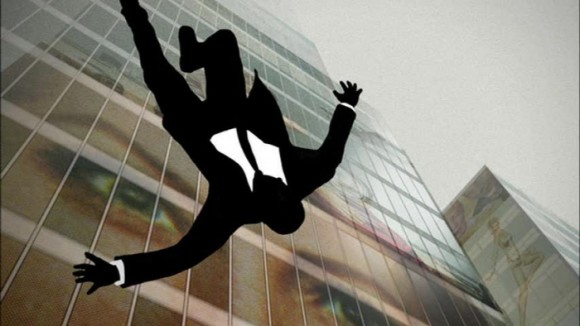 Falling.....[/caption]
Falling.....[/caption]
[1] Tim Griffin, “Art and agency,” Artforum International 47, no. 2 (October 2008): 59, Academic OneFile, Web (accessed May 15, 2011).
[2] Roland Marchand, Advertising the American Dream: Making Way for Modernity, 1920-1940 (Berkeley: University of California Press, 1985), xv.
[3] Warren Susman, Culture as History: The Transformation of American Society in the Twentieth Century (Washington: Smithsonian Institution Press, 2003), 128.
[4] Marchand, Advertising the American Dream, 130.
[5] Jean Kilbourne, Can’t Buy My Love: How Advertising Changes the Way We Think and Feel (New York: Touchstone, 1999), 57.
[6] Ibid., 114.
[7] Kenneth Nguyen, “Nostalgia just ain’t what it used to be,” The Age, October 18, 2007.
[8] Kilbourne, Can’t Buy My Love, 74.
[9] Marchand, Advertising the American Dream, xviii.
[10] Marchand, Advertising the American Dream, 167.
[11] Ibid.
[12] Betty Friedan, The Feminine Mystique (New York: W.W. Norton & Company, Inc, 1963), 18.
[13] Marchand, Advertising the American Dream, 131.
[14] Ibid., 169.
[15] William O’Barr, “Mad Men: Gender, Race, Ethnicity, Sexuality, and Class,” Advertising & Society Review 11, no. 4 (2011), Project MUSE, Web (accessed May 15, 2011).
[16] Kilbourne, Can’t Buy My Love, 69.
[17] Friedan, The Feminine Mystique, 219.
[18] Kilbourne, Can’t Buy My Love, 26.
[19] Ibid., 93.
[20] Kilbourne, Can’t Buy My Love, 29.
[21] Friedan, The Feminine Mystique, 266.
[22] Kilbourne, Can’t Buy My Love, 92.
[23] Daniel Mendelsohn, “The irresistible secret of those Mad Men – they’re our parents; The adland drama is feted for its ecovation of an era but its real power lies in touching our deepest feelings, says Daniel Mendelsohn,” The Sunday Times, March 20, 2011.
[24] Marchand, Advertising the American Dream, xvii.
[25] Kilbourne, Can’t Buy My Love, 55,71.
[26] Marchand, Advertising the American Dream, 162.
[27] Susman, Culture as History, 111.
[28] Jennie Yabroff, “A Word From Our Sponsor; 'Mad Men' may be set in the 1960s, but the show's period-piece ads tell us plenty about ourselves,” Newsweek, August 4, 2008.
[29] Kilbourne, Can’t Buy My Love, 77.
[30] David Ogilvy, Confessions of an Advertising Man, (New York: Atheneum, 1963).
[31] David Mendelsohn, The Sunday Times, March 20, 2011.
[32] David Mendelsohn, The Sunday Times, March 20, 2011.
[33] Tim Griffin, “Art and agency,” Artforum International, 59.
[34] Adam Cohen, “’Mad Men’ and the Thrill of Other People’s Misery in Sour Times,” The New York Times, October 17, 2009.

